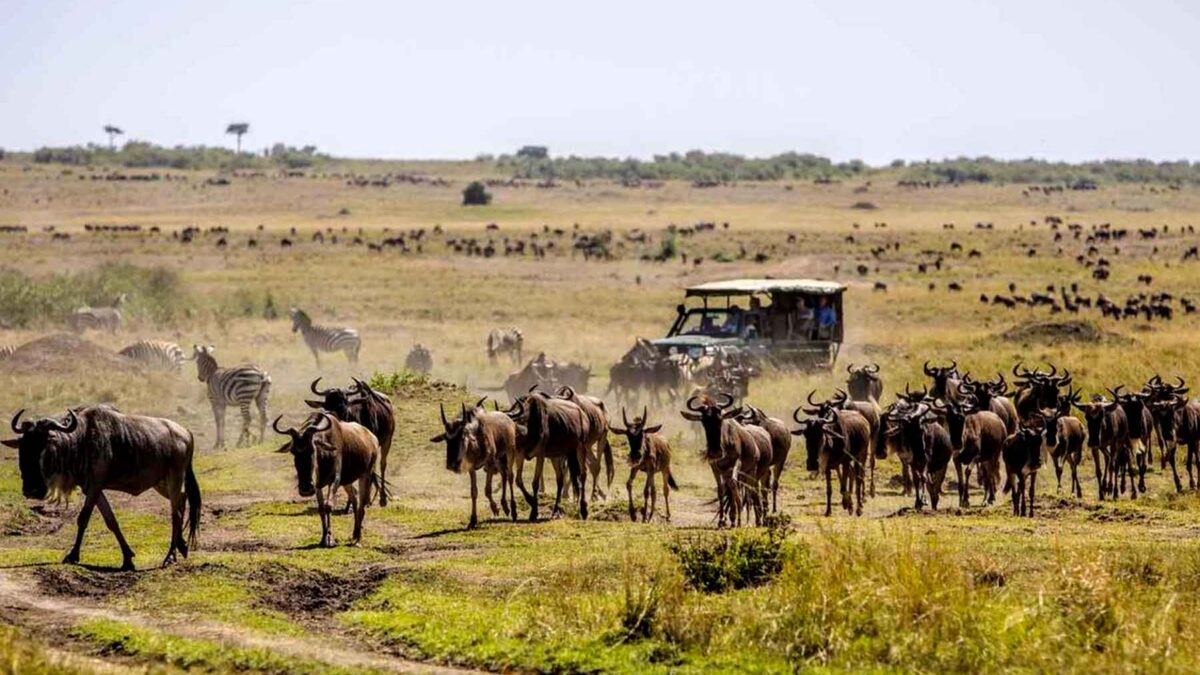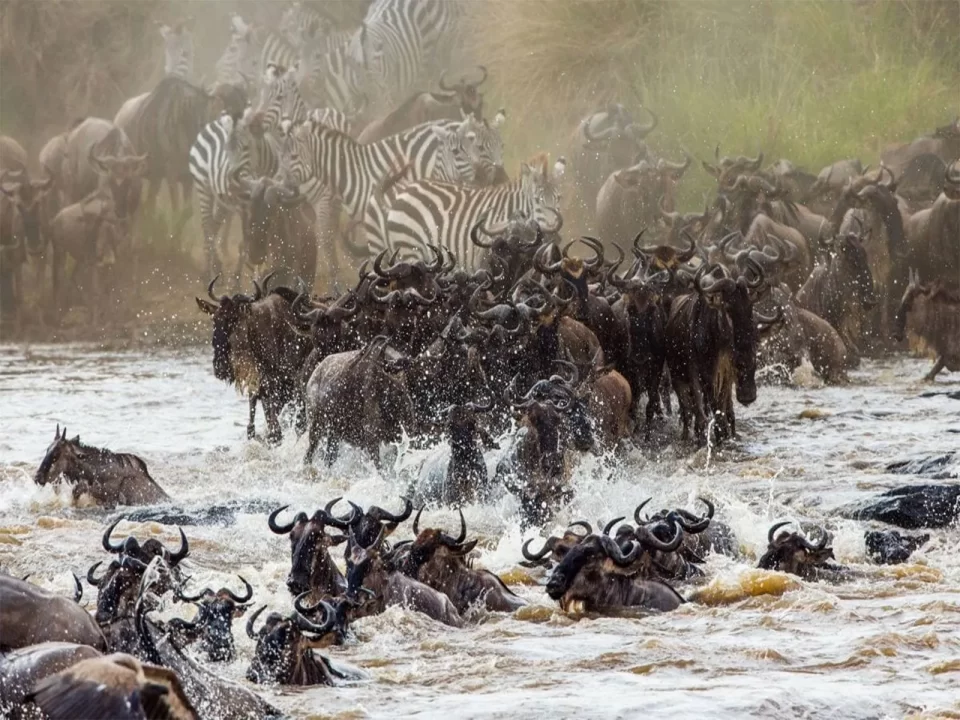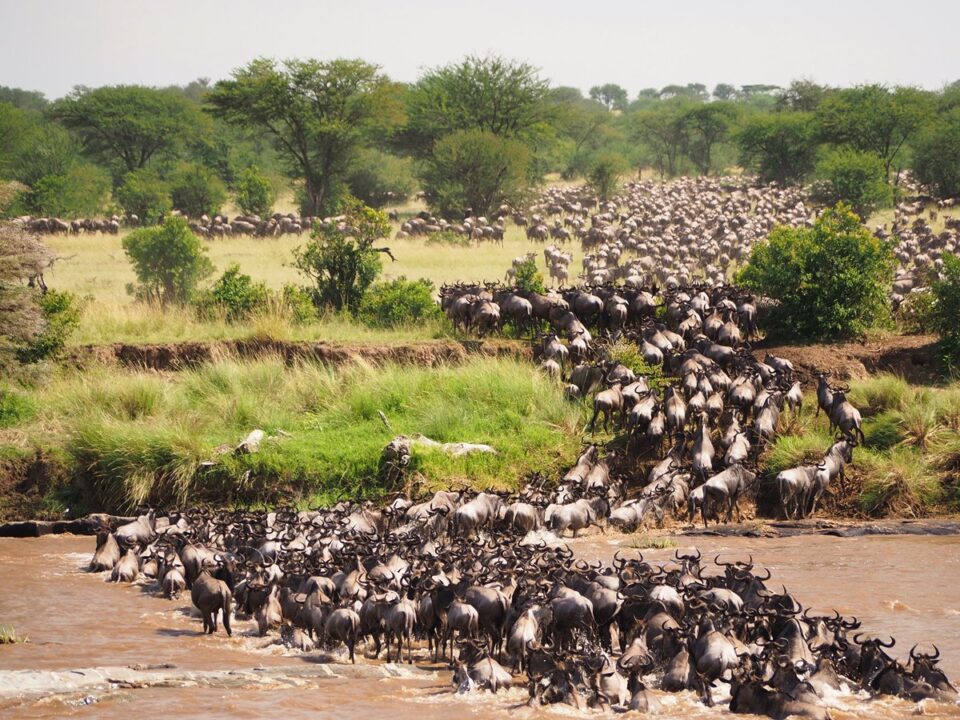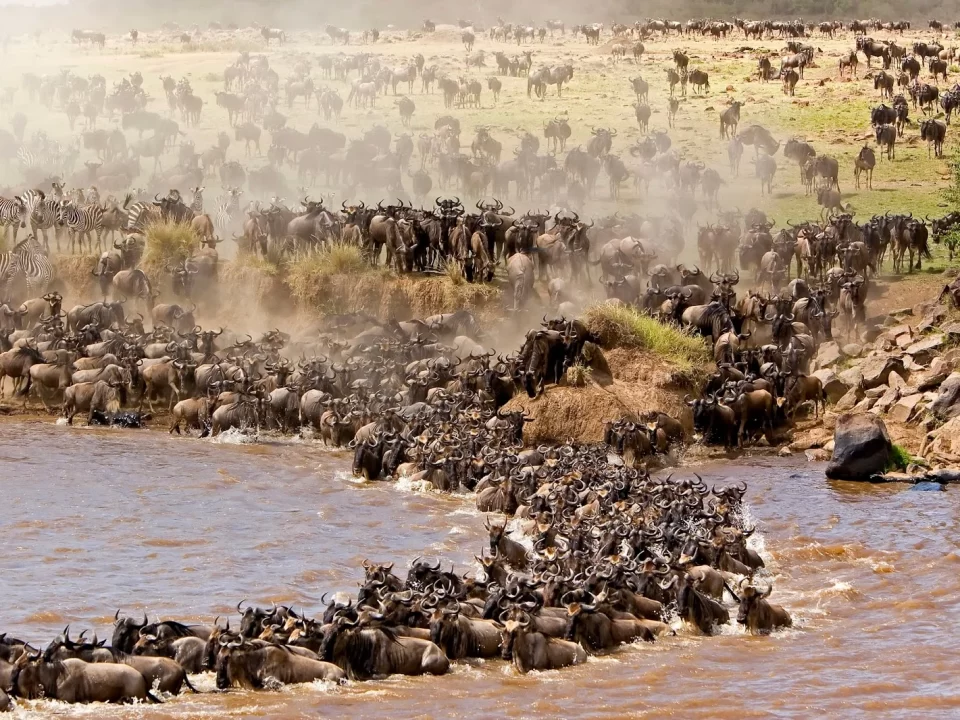Guide to 2024/2025 Wildebeest Migration Safari

Great Wildebeest Migration Safari Guide
March 7, 2024
African Safari in August
March 7, 2024Guide to 2024/2025 Wildebeest Migration Safari – Witness the Marvels of African Wildlife
Embark on an exhilarating journey with Trek Africa Expeditions as we guide you through the intricacies of the 2024/2025 Wildebeest Migration Safari in Kenya and Tanzania. Each year, almost two million wildebeest and 20,000 plains game animals embark on a monumental migration from Tanzania’s Serengeti to the southern reaches of Kenya’s Masai Mara. This relentless journey spans nearly 3000 kilometers, dictated by the ebb and flow of seasons, rainfall, and the allure of lush grazing grounds and life-sustaining water sources.
This remarkable odyssey is not confined to a specific timeframe, offering a year-round spectacle for avid travelers, nature enthusiasts, and those seeking a deeper connection with the African wilderness. The Great Migration operates in a perpetual, clockwise rhythm, defying conventional start or end points. To navigate this unpredictability, our innovative Herd Tracker app was created, empowering you to monitor wildebeest movements and curate a safari experience tailored to your preferences and budget.
Insights into the 2024/2025 Wildebeest Migration:
Resourceful Planning and Wildebeest Movement Tracking:
Delve into our guide for the 2024/2025 Wildebeest Migration, designed to provide a seamless safari experience. Trek Africa Expeditions orchestrates safaris in Kenya and Tanzania, allowing you to witness the awe-inspiring wildebeest migration. Whether you choose from our existing safari packages or customize your journey, our seasoned safari experts, affiliate camps, and on-ground guides collaborate to furnish real-time information on herd locations and the predators accompanying them.
Understanding Each Month of the Migration:
January:
January, akin to June, poses challenges in prediction due to reliance on rainfall in the southern plains. Expect to witness female wildebeests in the final stages of pregnancy, leading to swift movements in pursuit of nourishing grasslands for impending births.
Recommended Stay: Central locations, adaptable to movement north or south based on circumstances, provide optimal positioning for a Serengeti migration safari in January.
February:
This month marks the calving season, characterized by the birth of wildebeest and zebra offspring. The herds remain relatively stationary, offering high chances of witnessing births and increased predator activity.
Recommended Stay: Lakes Ndutu and Masek regions serve as focal points, ensuring memorable moments during your February Serengeti migration safari.
March:
March introduces wetter conditions with lush green grass, attracting the wildebeest herds. Slow and predictable movements characterize this period, creating opportunities for encounters with lion and leopard, drawn by vulnerable one-month-old calves.
Recommended Stay: Northern Ndutu camps within the Serengeti National Park present ideal accommodation options during March.
April:
April brings long rains, adding an element of challenge with wet plains and slippery soil. Overcoming these conditions, you’ll witness the herds gaining momentum as newborns become mobile.
Recommended Stay: Simba kopjes regions, Moru, and Kusini offer prime viewing of the migration in April, with notable predator interactions.
May:
The wettest month in the Serengeti, May accelerates the herds’ pace as the calves become more mobile and feed less frequently.
Recommended Stay: Lake Magadi, just north of Moru and south of Mokoma, becomes a focal point for the migratory herds.
June:
June signifies the end of the rainy season, presenting lush green plains and extensive wildebeest coverage. Traditionally the Grumeti River crossing period, it offers a preview of the challenges awaiting in July and August.
Recommended Stay: A dual approach, with time on both sides of Nyamuma and Simiti Hills, optimizes your chances to witness migration dynamics.
July:
July introduces arid landscapes as the dry season approaches, prompting the wildebeest to seek water and greener pastures. The Grumeti and Mara River crossings become prominent, complete with crocodile encounters.
Recommended Stay: For early river crossings, focus on the Grumeti River. Later in July, proximity to the Mara River enhances your chances of witnessing additional crossings.
August:
August, a hot and humid month, amplifies the search for lush grass. The herds face the perilous task of crossing the crocodile-infested Mara River.
Recommended Stay: Booking accommodations on both sides of the Mara River ensures an immersive experience during August’s consistent river crossings.
September:
Continuing the hot and dry trend, September witnesses the majority of wildebeests in the Greater Masai Mara area, feasting on green grass resources before moving north.
Recommended Stay: With a predictable herd location, the Masai Mara side is the preferred choice for September.
October:
As the dry season peaks in October, the wildebeest herds transition back into the Serengeti, moving through Loliondo in the east.
Recommended Stay: Staying in the Masai Mara provides optimal opportunities to witness the herds during October.
November:
November introduces cooler weather and early rains in the Serengeti. The herds settle in the Lobo, Mbuze Mawe, and Seronera Valley areas, where water sources are abundant.
Recommended Stay: Southeastern Masai Mara combined with northeastern Serengeti provides an ideal vantage point in November.
December:
December brings wet weather with short rains in the Central Serengeti. The herds hasten their southward movement, reaching the Southern Plains within days.
Recommended Stay: South of Lobo becomes the prime location for observing the wildebeest herds in December.
Key Notables for the 2024/2025 Wildebeest Migration Safari:
Unpredictable River Crossings:
Contrary to popular belief, river crossings cannot be predicted, even by the wildebeests themselves. The timing varies, and a river crossing may happen immediately, after days of grazing, or involve a change of direction.
Year-round Migration:
Dispelling the misconception of a migration confined to July-October, the Great Migration unfolds throughout the year, offering diverse and equally exciting wildlife experiences. Climate change has disrupted the predictability of rainy seasons, emphasizing the need for extended safari durations.
Strategic Planning:
Planning for as much time on safari as possible is crucial. The idea of flying in for a brief visit to witness a river crossing and departing is unrealistic, considering the unpredictable nature of the Migration.
Detailed Calendar Breakdown:
While a general breakdown of herd locations is provided, it is essential to acknowledge the dynamic nature of the Wildebeest Migration, driven by rain patterns that can vary in timing.
For in-depth insights into the 2024/2025 Wildebeest Migration Safari, contact Trek Africa Expeditions. Our detailed information and expert guidance ensure an unforgettable safari experience, bringing you closer to the wonders of the wildebeest migration.




